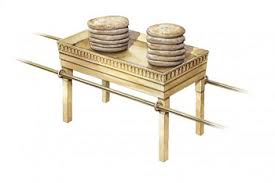The Merarites
First Chronicles 23: 21-32
David started making the arrangements for Temple services
several years before the end of his life.
The Levites fulfilled the priestly roles in Isra’el and bore the responsibility of caring for the Tabernacle. The Gershonites, Kohathites and Merarites each had specific roles within the Levitical culture. The Merarites had the task of maintaining and carrying from place to place the pillars, bases, frames, pegs, and cords that created the structure of the Tabernacle (see the commentary on Numbers, to see link click Au – The Clan of Merari). Since the Israelites were often on the move, the Tabernacle often had to be taken up and moved. The Merarites were given ox carts to help with the transport of their items. They received four carts and eight oxen (Numbers 7:6-8).
Representatives of the Merarites participated in David’s move of the Ark to Jerusalem (First Chronicles 15:6), served as Tabernacle musicians (First Chronicles 15:17 and 19) and gatekeepers (1 Chronicles 26:10 and 19) shared in Hezekiah’s (Second Chronicles 29:12) and Josiah’s (SecondChronicles 34:12) reforms, and returned from exile to assist in the new Temple (Ezra 8:19). Their place in the wilderness was on the northern side of the Tabernacle (see the commentary on Exodus Ep – The Camp of the Twelve Tribes of Isra’el).
As Levites, the Gershonites, Kohathites, and Merarites did not receive a specific territory in the Promised Land. Rather, they were given cities and pasturelands from among the territories of the other tribes by the command of ADONAI. The Merarites received twelve cities from the tribes of Reuben, Gad and Zebulun. The distribution of the cities was decided by the drawing of lots (Joshua 21:1–8), and six of the Levitical cities were designated as cities of refuge.
As for Levi’s third son, Merari, he had two sons, Mahli and Mushi. The descendants of Mahli were Eleazar and Kish. Eleazar died without having sons; he had only daughers. Their cousins, the sons of Kish, married them. The descendants of Kish were Mahli (not Merari’s son), Eder and Jerimoth (First Chronicles 23:21-23). Although the daughters of Eleazar were married to their kinsmen of the family of Kish, this did not effect a merging of the fathers’ houses of Kish and Eleazar into one house of Mahli. Rather, following the law of inheritance, the daughters maintained an independent house of Eleazar.520 So with Mahli’s two descendents (Eleazar and Kush), and Mushi’s three descendants (another man name Mahli, Eder and Jerimoth), the total of twenty-four divisions is reached.
The Chronicler concluded the lists by reiterating David’s purposes in allocating the Levites’ assignments. These were the descendants of Levi by their families – the heads of families as they were registered under their names and counted individually, that is, the workers twenty years old or more who served in the Temple of ADONAI. For David had said: Since the LORD, the God of Isra’el, has granted rest to His people and has come to dwell in Yerushalayim forever, the Levites no longer need to carry the Tabernacle or any of the articles used in its service. Since their duties included a much larger burden, David lowered the age of Levitical service to twenty from the previously designated age of thirty. According to the last instructions of David the Levites were counted from those twenty years old or more (First Chronicles 23:24-27). This permitted many more men to minister.521
The duty of the Levites was to help Aaron’s descendants in the service of the Temple of YHVH; to be in charge of the courtyards, the side rooms, the purification of all sacred things and the performance of other duties at the Tabernacle (First Chronicles 23:28).

They were in charge of the bread of the Presence set out on the Table (see the commentary on Exodus Fo – The Bread of the Presence in the Sanctuary: Christ, the Bread of Life), the special flour for the grain offerings, the thin loaves made without yeast, the baking and the mixing, and all measurements of quantity and size (First Chronicles 23:29).
The daily services of praise by the Levites accompanied the regular sacrifices that were fixed for every morning and evening, and were offered up by the priests (Exodus 29:38-39; Numbers 28:3-8).522 They were also to stand every morning to thank and praise ADONAI. They were to do the same in the evening and whenever burnt offerings were presented to the LORD on the Shabbat’s at the New Moon feasts and at the appointed festivals. They were to serve before the LORD regularly in the proper number and in the way prescribed for them (First Chronicles 23:30-31).
And so the Levites carried out their responsibilities for the Tabernacle (see the commentary on Exodus Eq – Christ in the Tabernacle) for the Holy Place (see the commentary on Exodus Fj – The Outer Veil of the Sanctuary) and, under their relatives and descendants of Aaron, for the service of the Temple of YHVH (First Chronicles 23:32).



Leave A Comment